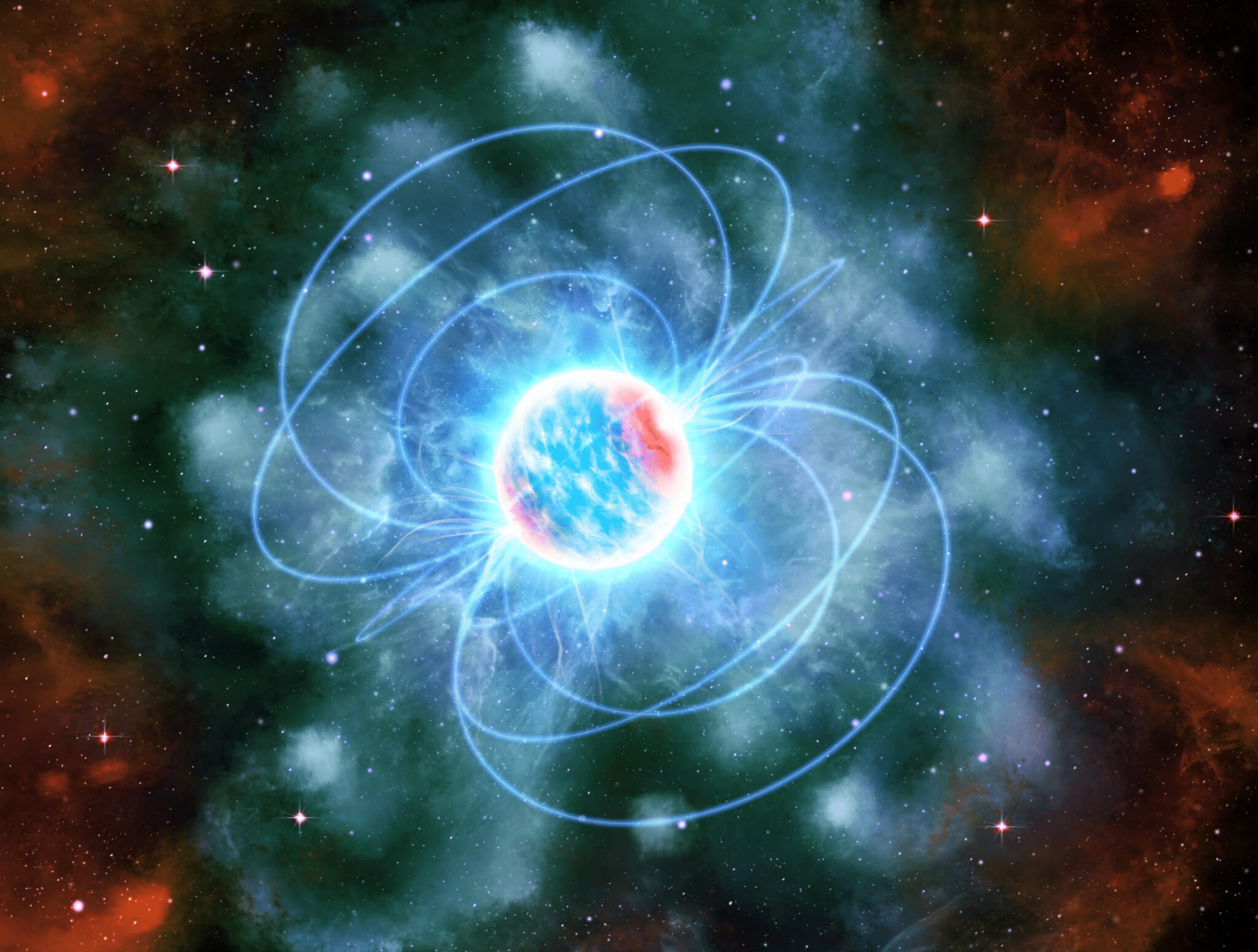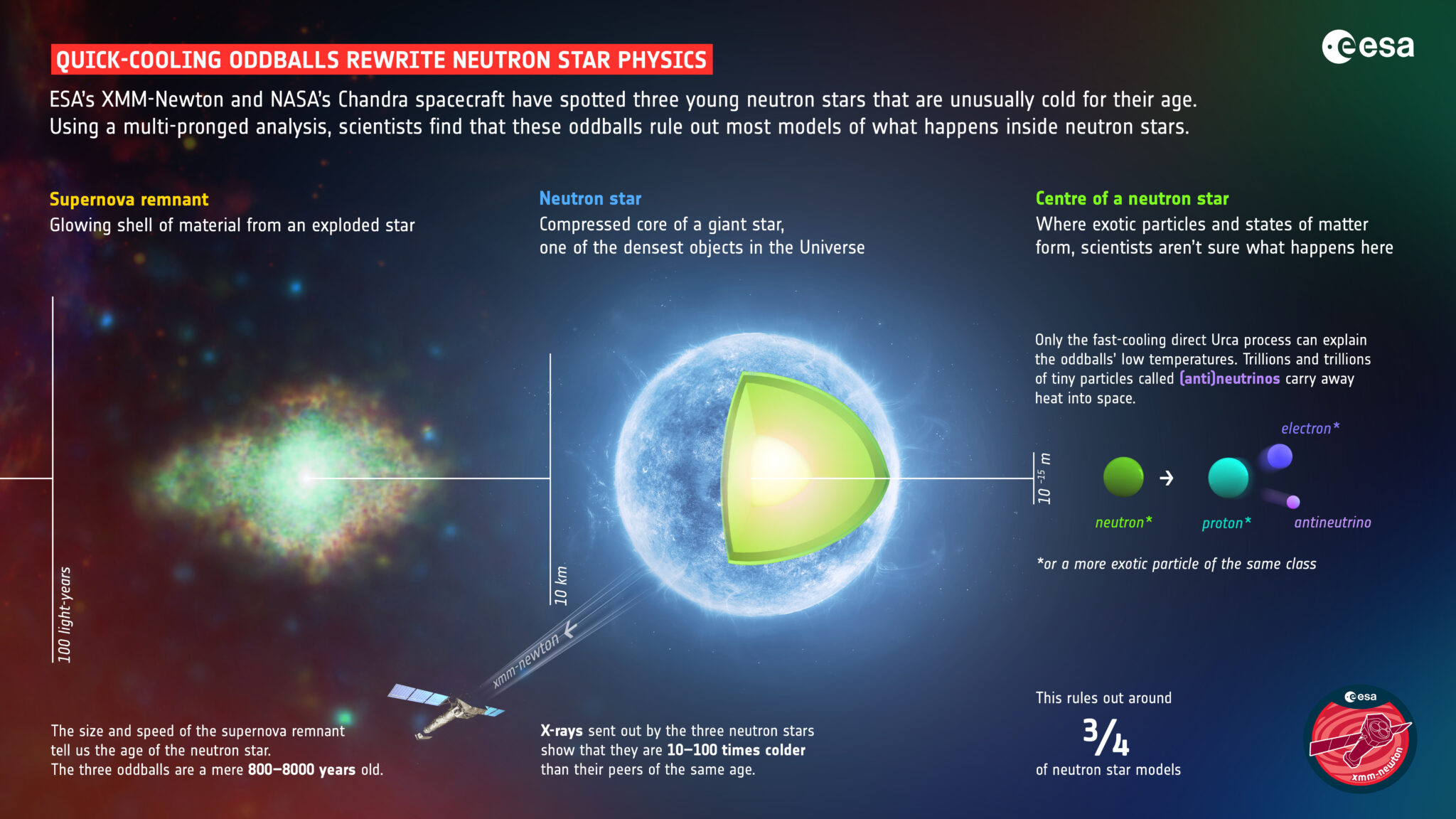A team of IEEC astronomers discovers three neutron stars too cold for their age
- Three neutron stars detected by ESA’s XMM-Newton and NASA’s Chandra telescopes are between 10 and 100 times colder than others of their same age
- This finding rules out around 75% of known neutron star models
- IEEC researchers at the Institute of Space Sciences lead the study published in Nature Astronomy

Caption: An artist’s impression of a neutron star, shown as a bright blue and red sphere with spark-like features flying off it. Several blue magnetic field lines loop connect the sphere’s two poles.
Credits: ICE-CSIC/D. Futselaar/Marino et al.
The European Space Agency’s (ESA) XMM-Newton and NASA’s Chandra spacecraft have detected three young neutron stars that are unusually cold for their age. By comparing their properties to different neutron star models, a team of astronomers from the Institute of Space Studies of Catalonia (IEEC — Institut d’Estudis Espacials de Catalunya) at the Institute of Space Sciences (ICE-CSIC), in collaboration with the University of Alicante, concludes on a study published in Nature Astronomy that the oddballs’ low temperatures disqualify around 75% of known models. This is a big step towards uncovering the one neutron star ‘equation of state’ that rules them all, with important implications for the fundamental laws of the Universe.
After stellar mass black holes, neutron stars are the densest objects in the Universe. Each neutron star is the compressed core of a giant star, left behind after the star exploded in a supernova. After running out of fuel, the star’s core implodes under the force of gravity while its outer layers are blasted outward into space.
Matter in the centre of a neutron star is squeezed so hard that scientists still don’t know what form it takes. Neutron stars get their name from the fact that under this immense pressure, even atoms collapse: electrons merge with atomic cores, turning protons into neutrons. But it might get even weirder, as the extreme heat and pressure may stabilise more exotic particles that don’t survive anywhere else, or possibly melt particles together into a swirling soup of their constituent quarks.
What happens inside a neutron star is described by the so-called ‘equation of state’, a theoretical model that describes what physical processes can occur inside a neutron star. The problem is, scientists don’t yet know which of the hundreds of possible equation of state models is correct. While the behaviour of individual neutron stars may depend on properties like their mass or how fast they spin, all neutron stars must obey the same equation of state.
Too cold
Digging into data from ESA’s XMM-Newton and NASA’s Chandra missions, scientists discovered three exceptionally young and cold neutron stars that are 10–100 times colder than their peers of the same age. By comparing their properties to the cooling rates predicted by different models, the researchers conclude that the existence of these three oddballs rules out most proposed equations of state.
“The young age and the cold surface temperature of these three neutron stars can only be explained by invoking a fast cooling mechanism. Since enhanced cooling can be activated only by certain equations of state, this allows us to exclude a significant portion of the possible models,” explains astrophysicist Nanda Rea, whose research group at the ICE-CSIC and the IEEC led the investigation.

Caption: Quick-cooling oddballs rewrite neutron star physics.
Credits: ESA. Acknowledgement: Work performed by ATG under contract for ESA. License: CC BY-SA 3.0 IGO or ESA Standard License.
Uncovering the true neutron star equation of state also has important implications for the fundamental laws of the Universe. Physicists famously don’t yet know how to stitch together the theory of general relativity (which describes the effects of gravity over large scales) with quantum mechanics (which describes what happens at the level of particles). Neutron stars are the best testing ground for this as they have densities and gravitation far beyond anything we can create on Earth.
Joining forces: four steps to discovery
The three oddball neutron stars being so cold makes them too dim for most X-ray observatories to see. “The superb sensitivity of XMM-Newton and Chandra made it possible not only to detect these neutron stars, but to collect enough light to determine their temperatures and other properties,” says Camille Diez, ESA research fellow who works on XMM-Newton data.
However, the sensitive measurements were only the first step towards being able to draw conclusions about what these oddballs mean for the neutron star equation of state. To this end, Nanda Rea’s research team at ICE-CSIC combined the complementary expertise of Alessio Marino, Clara Dehman and Konstantinos Kovlakas, as well as Daniele Viganò, co-author of the magnetic field simulation code.
IEEC postdoctoral researcher at the ICE-CSIC and first author of the paper Alessio Marino led on determining the physical properties of the neutron stars. “Three of these neutron stars are much cooler than the others at similar ages. This was a big clue that something weird might be going on inside these objects, which we need to understand,” he says. The team could deduce the temperatures of the neutron stars from the X-rays sent out from their surfaces, while the sizes and speeds of the surrounding supernova remnants gave an accurate indication of their ages.
“Three of these neutron stars are much cooler than the others at similar ages. This was a big clue that something weird might be going on inside these objects,” says Alessio Marino.
Next, Clara Dehman, postdoctoral researcher at the University of Alicante, took the lead on computing neutron star ‘cooling curves’ for equations of state that incorporate different cooling mechanisms. This entails plotting what each model predicts for how a neutron star’s luminosity—a characteristic directly related to its temperature—changes over time. The shape of these curves depends on several different properties of a neutron star, not all of which can be determined accurately from observations. For this reason, the team computed the cooling curves for a range of possible neutron star masses and magnetic field strengths.
“Because more massive neutron stars have more particles, special processes that cause neutron stars to cool more rapidly might be triggered,” says co-author Dehman, who worked in this study while doing her PhD thesis at ICE-CSIC. “It’s like having early answers filled in on a crossword puzzle – it makes filling in the rest of the answers much easier.”, she adds.
Finally, a statistical analysis led by Konstantinos Kovlakas, IEEC researcher at the ICE-CSIC, brought it all together. Using machine learning to determine how well the simulated cooling curves align with the oddballs’ properties showed that equations of state without a fast cooling mechanism have zero chance of matching the data.
“If we are able to eliminate some of the possibilities about what is inside a neutron star, then the next question we have to ask is, what is left?”, points out co-author Kovlakas.
“Neutron star research crosses many scientific disciplines, spanning from particle physics to gravitational waves. The success of this work demonstrates how fundamental teamwork is to advancing our understanding of the Universe,” concludes Nanda Rea.
Press release prepared in collaboration with the Institute of Space Sciences.
More information
This research is presented in a paper entitled “Constraints on the dense matter equation of state from young and cold isolated neutron stars”, by Alessio Marino, Clara Dehman, Konstantinos Kovlakas, Nanda Rea, José A. Pons and Daniele Viganò, to appear in the journal Nature Astronomy on 20 June 2024. DOI: 10.1038/s41550-024-02291-y
Contacts
IEEC Communication Office
Castelldefels, Barcelona
E-mail: comunicacio@ieec.cat
Lead Researcher at the IEEC
Castelldefels, Barcelona
Alessio Marino
Institute of Space Studies of Catalonia (IEEC)
Institute of Space Sciences (ICE-CSIC)
E-mail: marino@ieec.cat
About the IEEC
The Institute of Space Studies of Catalonia (IEEC — Institut d’Estudis Espacials de Catalunya) promotes and coordinates space research and technology development in Catalonia for the benefit of society. IEEC fosters collaborations both locally and worldwide and is an efficient agent of knowledge, innovation and technology transfer. As a result of more than 25 years of high-quality research, done in collaboration with major international organisations, IEEC ranks among the best international research centres, focusing on areas such as: astrophysics, cosmology, planetary science, and Earth Observation. IEEC’s engineering division develops instrumentation for ground- and space-based projects, and has extensive experience in working with private or public organisations from the aerospace and other innovation sectors.
The IEEC is a non-profit public sector foundation that was established in February 1996. It has a Board of Trustees composed of the Generalitat de Catalunya, Universitat de Barcelona (UB), Universitat Autònoma de Barcelona (UAB), Universitat Politècnica de Catalunya · BarcelonaTech (UPC), and the Spanish Research Council (CSIC). The IEEC is also a CERCA centre.
